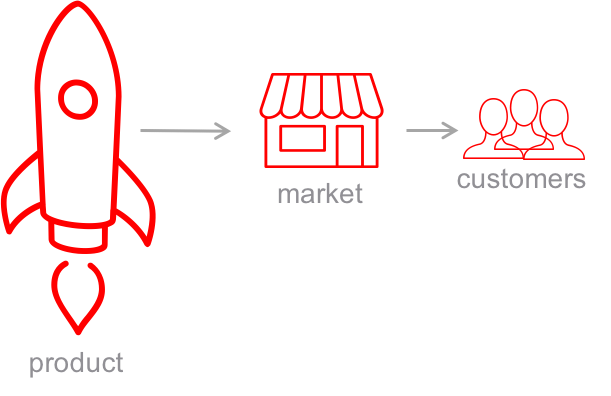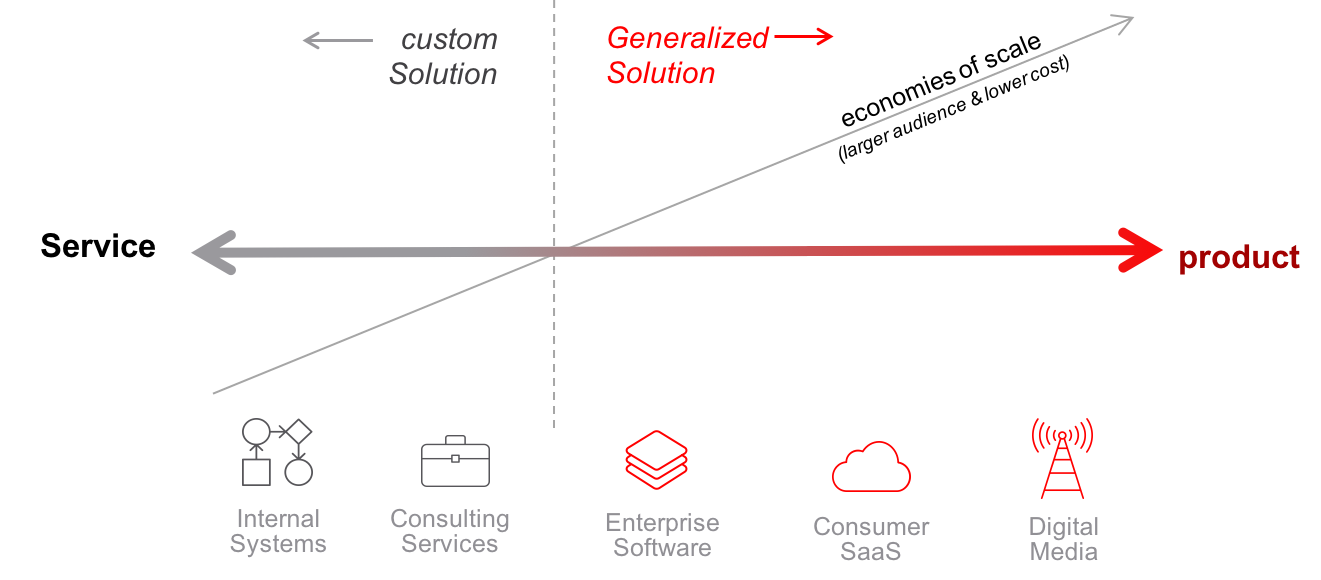What is a Product?
According to Merriam Webster, a product is “something (such as a service) that is marketed or sold as a commodity”. Oxford dictionary describes it as “an article or substance that is manufactured or refined for sale”. Common to both of these definitions, it is something created and sold. Merriam Webster further hints at the economies of scale that are an implicit dynamic of product as well.

My definition of a product is similar – it is a solution to a common problem that can be taken to market. It can be tangible or intangible. It can be for something that satisfies a practical need or an emotional desire. At its core, it is a generalized solution to a common problem, that can be produced at scale; and because it is produced at scale, a reasonable solution may be provided to a market that may not otherwise not seek a custom solution.
It is helpful to consider the Business Model Archetypes when defining a product, in order to think of a product relative to the other two primary business types – Services and Trade. In its purest since, a product is something that is created and then purchased by a customer – that product then directly conveys value to the customer. Compare this to a service wherein people do continued work in return for a fee, or trade where the primary conveyance of value is in establishing a pipeline of 3rd party products and monetized through arbitrage (selling for more than sourcing costs). It is possible to combine product with a trade or service to create hybrids models like the Subscription (ex SaaS) when you combine Product with Service or a Marketplace (e-commerce) when you combine product with a marketplace – consider however the core aspects of a product and what makes it unique.

Product v Service
The distinction between product and service in particular is interesting to consider. In the case of creating software, the development aspect may look very similar – an Agile team practicing Scrum with someone leading the effort, playing the Scrum Product Owner role for the team. The similarities stop there however. Strategically, a Product is intended to solve a common problem at scale through a generalized solution that meets the needs of the market. In the context of a service however, that development work is typically to achieve the specific needs of one customer and often is to fill the gaps between purchased/licensed products.
For example, the e-commerce company may use 3rd party products rather than building their own from the ground up, due to economies of scale. They may use an ecommerce platform for the website and catalog, and anther 3rd party software for warehouse/fulfillment management – but they must write software to transform and integration the data that flows in between the two. When that integration work is done, its often done as a service, for the e-commerce company – it is not a product.

Another point to consider – I’ve heard engineering of organizations biasing toward an “everything is a product” model recently. This is a shift from a traditional IT services model, to something that more closely approximates a Product Development model. The key idea here is that major system components should be designed, owned, and supported as if they were true products. While I applaud the movement in this direction since it better aligns internal development with Agile philosophy, it is important to call out that these are not true products – it is still a solution for a single (internal) customer, without a market, and without economies of scale.
There are exceptions to that statement– for example, if a company truly decided to ‘productize’ a system component and take it to market, or in the case of a major enterprise who has internal products that are available and compete with 3rd party solutions. In both of those cases, there may actually be some product work to be done, considering how to package and position that solution for the market. A litmus test to apply, is to ask whether you’re prioritizing the market analysis, user experience, and packaging work that would be necessary for this solution to be viable in the market?
Product vs Trade
Ecommerce is also interesting because it is an example of a Trade business. With few exceptions, the primary value proposition and differentiator of ecommerce, is the assortment of products that are brought for sale and the pricing of those products. In fact, looking at it from this perspective, the ecommerce platform and related customer shopping experience are actually supporting segments of the sales funnel.
For this reason, many eCommerce companies may not have a Product Management team – Site Merchandisers frequently will work as a Business owner with an agency or internal “IT” to develop what’s needed in support of their sales strategy. When Product Management does exist, its usually at a larger ecommerce company but is often still aligned to support the principal business function of Merchandising. This means the Product’s role is really more about optimizing the conversion funnel, more so than creating a differentiated product per se. Customer are buying the things sold via the e-commerce digital experience, not the platform itself.
There is, of course, an exception to this statement as well – to the extent that the digital experience itself is a strategically differentiated value-driver and customers specifically choose to interact because of what that experience provides, not just the prices or assortment sold through that experience, then the experience begins to approximate a product. An example of this would be a shopping comparison app that aggregates data across multiple retailers to make it easy for shoppers to find exactly what they need in one place. In this case, the digital experience is itself creating a solution for a broader market audience.
Conclusion
All of these examples illustrate the point about what a product is, and what it is not. When development is performed as a service in support of another business function, it can be structured to approximate product development, but if it is not a generalized solution for a broader market, not packaged nor positioned to succeed in the marketplace – then its not really a product.